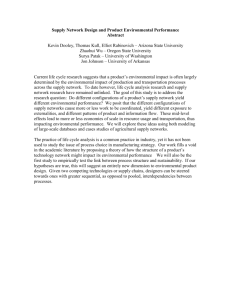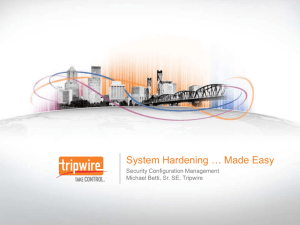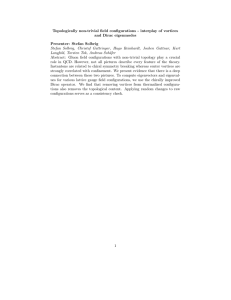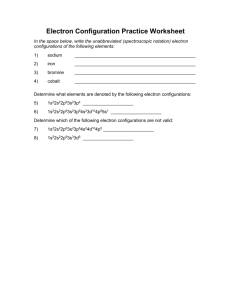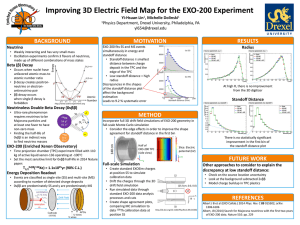J Joint Service Lightweight Standoff Chemical Agent Detector (JSLSCAD) DOD PROGRAMS
advertisement
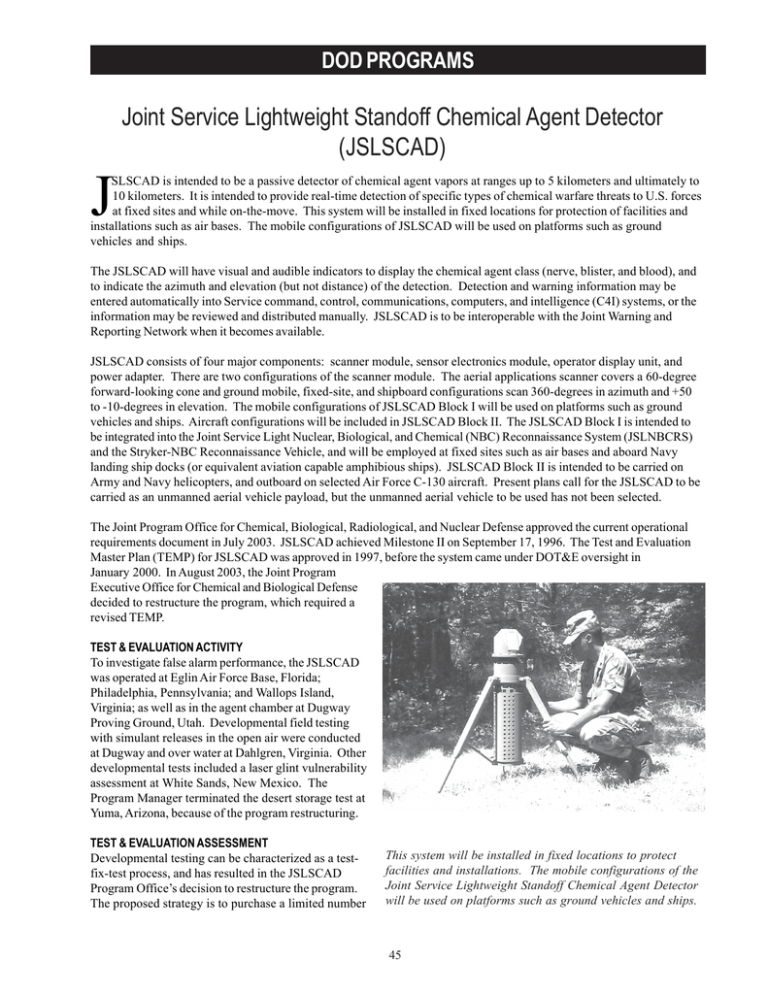
DOD PROGRAMS Joint Service Lightweight Standoff Chemical Agent Detector (JSLSCAD) J SLSCAD is intended to be a passive detector of chemical agent vapors at ranges up to 5 kilometers and ultimately to 10 kilometers. It is intended to provide real-time detection of specific types of chemical warfare threats to U.S. forces at fixed sites and while on-the-move. This system will be installed in fixed locations for protection of facilities and installations such as air bases. The mobile configurations of JSLSCAD will be used on platforms such as ground vehicles and ships. The JSLSCAD will have visual and audible indicators to display the chemical agent class (nerve, blister, and blood), and to indicate the azimuth and elevation (but not distance) of the detection. Detection and warning information may be entered automatically into Service command, control, communications, computers, and intelligence (C4I) systems, or the information may be reviewed and distributed manually. JSLSCAD is to be interoperable with the Joint Warning and Reporting Network when it becomes available. JSLSCAD consists of four major components: scanner module, sensor electronics module, operator display unit, and power adapter. There are two configurations of the scanner module. The aerial applications scanner covers a 60-degree forward-looking cone and ground mobile, fixed-site, and shipboard configurations scan 360-degrees in azimuth and +50 to -10-degrees in elevation. The mobile configurations of JSLSCAD Block I will be used on platforms such as ground vehicles and ships. Aircraft configurations will be included in JSLSCAD Block II. The JSLSCAD Block I is intended to be integrated into the Joint Service Light Nuclear, Biological, and Chemical (NBC) Reconnaissance System (JSLNBCRS) and the Stryker-NBC Reconnaissance Vehicle, and will be employed at fixed sites such as air bases and aboard Navy landing ship docks (or equivalent aviation capable amphibious ships). JSLSCAD Block II is intended to be carried on Army and Navy helicopters, and outboard on selected Air Force C-130 aircraft. Present plans call for the JSLSCAD to be carried as an unmanned aerial vehicle payload, but the unmanned aerial vehicle to be used has not been selected. The Joint Program Office for Chemical, Biological, Radiological, and Nuclear Defense approved the current operational requirements document in July 2003. JSLSCAD achieved Milestone II on September 17, 1996. The Test and Evaluation Master Plan (TEMP) for JSLSCAD was approved in 1997, before the system came under DOT&E oversight in January 2000. In August 2003, the Joint Program Executive Office for Chemical and Biological Defense decided to restructure the program, which required a revised TEMP. TEST & EVALUATION ACTIVITY To investigate false alarm performance, the JSLSCAD was operated at Eglin Air Force Base, Florida; Philadelphia, Pennsylvania; and Wallops Island, Virginia; as well as in the agent chamber at Dugway Proving Ground, Utah. Developmental field testing with simulant releases in the open air were conducted at Dugway and over water at Dahlgren, Virginia. Other developmental tests included a laser glint vulnerability assessment at White Sands, New Mexico. The Program Manager terminated the desert storage test at Yuma, Arizona, because of the program restructuring. TEST & EVALUATION ASSESSMENT Developmental testing can be characterized as a testfix-test process, and has resulted in the JSLSCAD Program Office’s decision to restructure the program. The proposed strategy is to purchase a limited number This system will be installed in fixed locations to protect facilities and installations. The mobile configurations of the Joint Service Lightweight Standoff Chemical Agent Detector will be used on platforms such as ground vehicles and ships. 45 DOD PROGRAMS of the current system for integration into the Stryker Reconnaissance Vehicle, the JSLNBCRS, and naval ships (fixed sites are also under consideration), and to purchase systems to meet the remainder of the requirement by a commercial buy. A test and evaluation strategy supporting this plan will be documented in the TEMP. The test strategy must include a protocol (such as that recommended by the National Research Council for passive infrared standoff detectors) that can provide confidence that JSLSCAD can detect and identify actual chemical warfare agents in a realistic environment at standoff distances. To implement the National Research Council recommendations, the developmental and operational evaluators require a signal-processing model, validated algorithm stimulator, background spectra, and an increased understanding of algorithm operations. Test limitations in the multi-Service operational test and evaluation will include the use of simulants instead of actual agents. Although the chosen simulants approximate spectral or physical characteristics of agents, they do not match them. Current testing is intended to support the ability to correlate concentration levels of real chemical vapors to concentration levels of simulant vapors. Even if a good correlation could be determined, the details of the algorithm in the JSLSCAD must be changed to allow it to detect a simulant vapor, and hence there could be some question about the system’s operational effectiveness on the battlefield. The implementation of the NRC recommendations in the test and evaluation strategy will increase the robustness of test and evaluation and mitigate this limitation. Other test limitations include the simulation of agent delivery by explosive, line, and stack-release devices instead of actual weapons and a restricted network warning capability instead of a full-theater or joint task force C4I system. Achieving ideal delivery conditions during tests is difficult due to the uncertainties of weather and the desired effects of the atmospheric mixing layer dictate that releases are best made during pre-dawn hours, but this is the same challenge any threat force would face. The test site at Dugway, an isolated, desert location that does not represent military bases, cities, or many types of battlefields where JSLSCAD likely will be deployed, is a limitation. The Navy plans to conduct a test at sea and the Air Force plans to test the system at Eglin Air Force Base. 46
